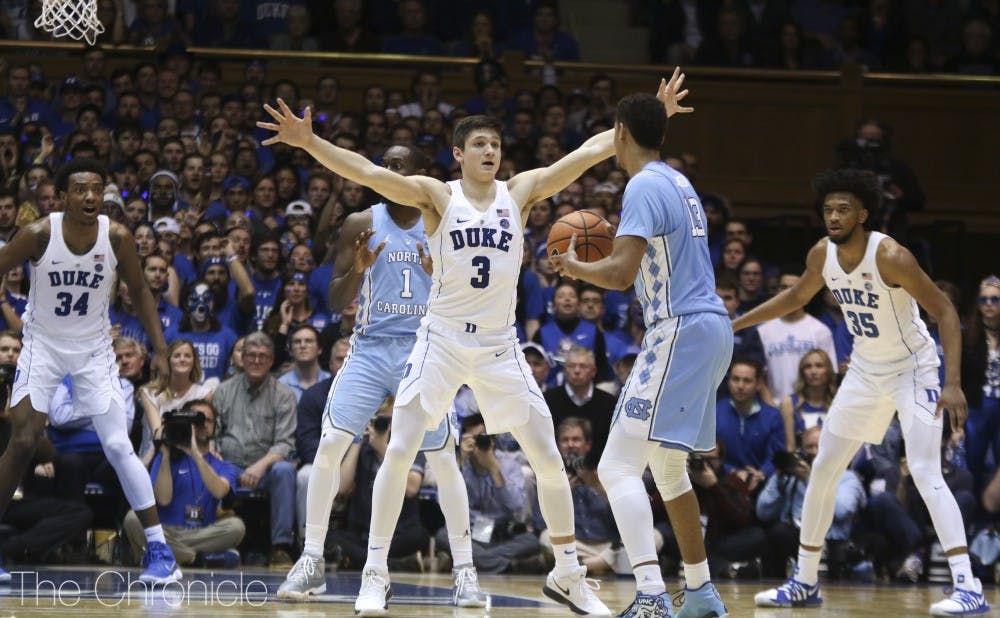After a dismal defensive start to the season sparked a constant debate about whether the Blue Devils could contain the nation’s most electric offenses, it’s safe to say Duke is in the zone defensively entering the ACC tournament.
The Blue Devils have completed the turnaround from a confused unit to one of the nation’s best at shutting opponents down after fully adopting a 2-3 zone defense in mid-February. In the first four games relying on the zone, Duke held each of its opponents to fewer than 60 points, a mark the Blue Devils achieved just three times in their first 25 games of the season.
Despite being known historically as a man-to-man coach, Duke head coach Mike Krzyzewski learned from Syracuse head coach and former Team USA assistant Jim Boeheim—perhaps the most famous champion of the zone scheme—and has created a masterpiece within his own program.
“We’ve played zone the whole year, but when we went kind of exclusively to it, it has really helped our guys communicate better,” Krzyzewski said after the Blue Devils’ 60-44 win against Syracuse Feb. 24. “Whatever we’re playing, we want to be the best, we don’t want to be second best.... I hope we’re better than Syracuse.”
Duke could not stop the ball throughout nonconference play, allowing each of its four Power-5 opponents to drop more than 75 points. Rather, the Blue Devils relied on their high-octane offense averaging more than 85 points per contest and needed multiple double-digit second-half comebacks to remain undefeated.
Duke’s defensive struggles continued through the start of conference play. The Blue Devils got off to a dismal 1-2 start after allowing 89, 93 and 96 points, respectively, in their first three contests. Duke allowed each of those opponents to convert better than 44 percent from the field and 35 percent from beyond the arc. Following the Blue Devils’ 96-85 loss at N.C. State Jan. 6, basketball statistician Ken Pomeroy had Duke ranked 104th in defensive efficiency.
The Blue Devils first committed to zone full-time Feb. 14 against Georgia Tech. Since that contest, Duke has dramatically turned things around, holding four of its six opponents to less than a 40 percent conversion rate from the field. In addition, the Blue Devils have especially locked down the perimeter, preventing opposing teams from shooting better than 30 percent on 3-pointers in each of their last five contests.
Duke’s recent stretch has helped it to rise 94 spots to the top 10 in KenPom defense.
“We’re doing a really good job of being active on defense,” senior Grayson Allen said after the Syracuse game. “Our talk has really picked up. We’re doing a much better job with the scouting report and knowing teams’ shooters and knowing teams’ strengths offensively, and trying to key in on those guys and make it tough for them.”
The Blue Devils’ ability to communicate in the zone has been one of the keys for their recent success. After struggling against the pick-and-roll for much of the season, Duke has done a much better job of late largely due to leadership by Allen at the head of the zone.
During Marvin Bagley III’s four-game absence due to a mild knee sprain, Allen not only transitioned to become the team’s primary ball-handler, but has remained the leader defensively as well, directing the zone from the top row.
“On defense, every possession we’re attacking the rim. Every possession we’re active,” Allen said after Duke defeated Louisville Feb. 21. “Really all I’m saying on the court is getting us to focus on each possession and take it one at a time so that we put together a 40-minute game.”
Perhaps the final key for Duke’s defensive success has been the expansion of the bench and the increased role of sophomore Javin DeLaurier. Despite averaging just 3.6 points and 4.3 rebounds per contest, DeLaurier has made his presence felt on defense with his length and aggression, diving for loose balls, and he started the last two games of the regular season in place of freshman point guard Trevon Duval.
At 6-foot-10, DeLaurier provides additional size on the baseline next to freshmen Bagley and Wendell Carter Jr., who maintain a large size advantage over most opponents.
“The two things that are the toughest things that you can’t simulate when you’re playing really good people are length and quickness,” Krzyzewski said of starting DeLaurier against Syracuse. “Both teams are decent in terms of quickness, but both teams have extraordinary length when they’re out there, and what you think you see, even if you’re in the stands, if you were on the court I’m not quite sure you’d see it. It’s difficult.”
Get The Chronicle straight to your inbox
Signup for our weekly newsletter. Cancel at any time.
Digital Strategy Director for Vol. 115, Michael was previously Sports Editor for Vol. 114 and Assistant Blue Zone Editor for Vol. 113. Michael is a senior majoring in Statistical Science and is interested in data analytics and using data to make insights.

